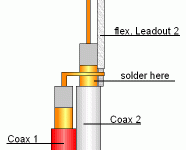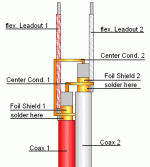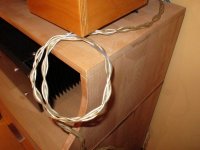Yes, i know that picture. The problem is that the Coper foil may be too fragile to solder. We will see
Yes, i know that picture. The problem is that the Coper foil may be too fragile to solder. We will see
It also melts the insulation to the inner cable and shorts out.
Been there, done that!😀
They need patience and care to build and get working.
Yes, i know that picture. The problem is that the Coper foil may be too fragile to solder. We will see
Slide a small piece of paper under the foil when soldering. That will help. Also, use low-temp solder. (And low-temp iron 🙂 )
Can someone advice on some diy speaker wire for my recently build F5. I've read that cat5 wire is good but don't know what precautions i must have. What specs from the amp do i have to consider when building the speaker cable? i have 8ohm speakers.
i think not every speaker wire is ideal for all the amps out there.
just trying to learn something.
I have done Wires according to this Patent:
us patent 6,215,062
Buyed cabels with 2,5mm^2 in the wanted Color and material.
And then braid.
Works really well, have a good optic, and 5mm^2 for every polarity of Speaker cabel should be enough for everything.
Maybe pics follow...
Good old Kimber cable. I made some similar cables by braiding CAT5 conductors. I forget the exact recipe i used but I believe I made three lengths of three braided conductors. Those three lengths were then braided to make a cable comprised of 27 conductors braided together. Using four conductors per bundle as in Kimber's braid would have made things more balanced.I have done Wires according to this Patent:
us patent 6,215,062
Buyed cabels with 2,5mm^2 in the wanted Color and material.
And then braid.
Works really well, have a good optic, and 5mm^2 for every polarity of Speaker cabel should be enough for everything.
Maybe pics follow...
more balanced means ?
Balanced impedance means that the impedance to common/earth seen by both conductors is the same. How do you make them more balanced?
Balanced impedance means that the impedance to common/earth seen by both conductors is the same. How do you make them more balanced?
more balanced means ?
Balanced impedance means that the impedance to common/earth seen by both conductors is the same. How do you make them more balanced?
Well, in my home-brew cables, two of the braided bundles carried the + and one bundle carried the - . In the Kimber constructions + and - would have the same number of conductors. My use of "balanced" was incorrect. Also, my recollection of the construction technique that I used was incorrect -- it's been more than 15 years since I built those cables.
Here is the recipe that I used for my cables: http://www.venhaus1.com/diycatfivecables.html
The + and - connections end up with the same number of conductors because of the cables are constructed.
Last edited:
DIY cable face-off
Here is a nice comparison of some DIY cable topologies.
The Kimber construction in the patent that was cited is similar to the Cat5 V2 in the article. The DIY Cat5 cables that I made years ago braided together 9 sections of the Cat5 V5 for each speaker channel.
Here is a nice comparison of some DIY cable topologies.
The Kimber construction in the patent that was cited is similar to the Cat5 V2 in the article. The DIY Cat5 cables that I made years ago braided together 9 sections of the Cat5 V5 for each speaker channel.
Last edited:
That's a form of braided cable.
It increases the gaps between the conductors.
That increased gap has three effects on the amplifier.
Increased inductance.
Decreased capacitance.
Increased interference.
It increases the gaps between the conductors.
That increased gap has three effects on the amplifier.
Increased inductance.
Decreased capacitance.
Increased interference.
That's a form of braided cable.
It increases the gaps between the conductors.
That increased gap has three effects on the amplifier.
Increased inductance.
Decreased capacitance.
Increased interference.
Theory is wonderful.
But what does it mean to the person who only judges by listening to the noise?
That looks braided lamp cord conductor. Not sure what that's a clone of but it has to measure pretty poorly.clone cable 😀
That looks braided lamp cord conductor. Not sure what that's a clone of but it has to measure pretty poorly.
Yes, a cable that measures so poorly Kimber patented it

To be fair, Kimber used solid core OFC conductors of a specified diameter. The braid minimizes inductance while allowing higher than normal capacitance. It interacts well with some amplifier/speaker combinations.Yes, a cable that measures so poorly Kimber patented it
Well, in my home-brew cables, two of the braided bundles carried the + and one bundle carried the - . In the Kimber constructions + and - would have the same number of conductors. My use of "balanced" was incorrect. Also, my recollection of the construction technique that I used was incorrect -- it's been more than 15 years since I built those cables.
Here is the recipe that I used for my cables: DIY Cat5 Speaker Cables
The + and - connections end up with the same number of conductors because of the cables are constructed.
I also used this DIY about ten years ago and am very happy with the cables and still use them with no issues using various amplifiers and receivers.
I think it's the opposite.To be fair, Kimber used solid core OFC conductors of a specified diameter. The braid minimizes inductance while allowing higher than normal capacitance. It interacts well with some amplifier/speaker combinations.
That's a form of braided cable.
It increases the gaps between the conductors.
That increased gap has three effects on the amplifier.
Increased inductance.
Decreased capacitance.
Increased interference.
I think it's the opposite.
Kimber cable measurements
"All 3 Kimber models of cable exhibit very low inductance. Due to the braided geometry of these cables, not only are they low inductance, but their inductance profile vs. frequency is ruler flat for the entire audio band. By weight of comparison, the inductance of the 8TC and 8PR was a mere .037 uF/ft and .041uH/ft, respectively; which was nearly four times lower than the 10AWG Bluejeans speaker cables that I revere so much. Interestingly Kimber rates the inductance of these cables as .042uH/ft which is slightly higher than I measured but shows they are conservative in their ratings."
"It is no surprise that when a cable is designed to be low inductance that its capacitance will be proportionally higher as a result. Unlike other cables that sandwich their conductors together, the Kimber manages to keep capacitance in check without the necessity of adding a zobel network on the speaker side of the cable to assure amplifier stability. Kimber’s published capacitance spec is 38pF for the 4PR and 90pF/ft for the 8PR and 100pF/ft for the 8TC. This is about what I measured as well, as you can see from the graph above. The Kimber 8TC and 8PR cables exhibit about four times higher capacitance than standard 10-12AWG zip cord, and twice as high as its 4PR sibling. Again I don’t see this as a show stopper especially since most people purchasing these types of cables are doing so for short runs (under 50 ft) and are likely using high quality amplification that doesn’t have stability issues driving moderately high capacitive cables."
A twisted pair with thinish insulation gets the cable pair closer together.
A spaced pair (or more) adds to the inductance and reduces the capacitance.
Comparison with a well spaced and nearly close coupled pair using very thick insulation is not a comparison to a twisted pair. Kimber are deliberately picking a bad comparison to delude their customers that don't know any better.
A spaced pair (or more) adds to the inductance and reduces the capacitance.
Comparison with a well spaced and nearly close coupled pair using very thick insulation is not a comparison to a twisted pair. Kimber are deliberately picking a bad comparison to delude their customers that don't know any better.
- Status
- Not open for further replies.
- Home
- Amplifiers
- Pass Labs
- DIY speaker wire for F5


